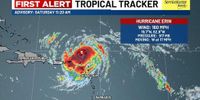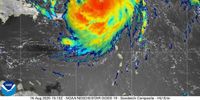On August 16, 2025, Hurricane Erin roared across the Atlantic, reaching a dramatic milestone as the first Category 5 hurricane of the 2025 Atlantic hurricane season. For those glued to weather updates, Erin’s rapid intensification was both a jaw-dropping and nerve-wracking spectacle—especially for residents of the northern Caribbean and the U.S. East Coast, who have learned not to take any storm lightly.
According to the National Hurricane Center (NHC), Erin’s sustained winds surged to a staggering 160 mph by Saturday morning. The hurricane’s center was pinpointed at about 105 miles north of Anguilla, or roughly 235 miles east-northeast of San Juan, Puerto Rico. The minimum central pressure had plummeted to 917 mb—a telltale sign of a very powerful storm indeed (Reuters, FOX 35, WCSC, WESH 2).
Jessica Dobson of the FOX 35 Storm Team described the situation as “rapid intensification,” noting that the storm had leapt from Category 1 to Category 5 in less than twenty-four hours. As Dobson put it, “Erin is continuing to rapidly intensify on Saturday morning, with its outer rain bands affecting the northern Leeward Islands.”
By 11:20 a.m. Saturday, the NHC had recorded Erin’s position at latitude 19.7 north, longitude 62.8 west, moving west-northwest at about 17 mph. Forecasters expected this motion to continue through the weekend, but with a gradual decrease in forward speed. Come early next week, Erin was projected to swing northward—a crucial turn that would determine the fate of millions along the Atlantic seaboard (WCSC, Reuters).
On its current track, Erin was expected to pass just north of the northern Leeward Islands, the Virgin Islands, and Puerto Rico over the weekend. The NHC warned that the storm’s outer rain bands would bring heavy rainfall—2 to 4 inches, with isolated pockets up to 6 inches—across these islands through Sunday. The threat of flash flooding, urban flooding, landslides, and mudslides loomed large, particularly in vulnerable areas (FOX 35, WESH 2, Reuters).
Swells generated by Erin were already battering the northern Leeward Islands, the Virgin Islands, Puerto Rico, Hispaniola, and the Turks and Caicos Islands. These rough seas were expected to spread to the Bahamas, Bermuda, and the U.S. East Coast by early next week, with forecasters cautioning that “life-threatening surf and rip currents” were a near certainty. By midweek, wave heights along Central Florida’s Atlantic beaches were predicted to reach 4 to 6 feet (WESH 2, FOX 35).
As a precaution, a Tropical Storm Watch was issued for St. Martin, St. Barthelemy, and Sint Maarten (FOX 35, WESH 2). Local officials urged residents and tourists alike to remain vigilant, especially around the coastline. “If you are on the coast, be extremely careful in the water due to the high risk of strong rip currents,” warned FOX 35’s Dobson.
Despite the storm’s ferocity, the consensus among meteorologists was that Erin would likely spare the U.S. mainland its worst. The storm was forecast to turn north between the U.S. East Coast and Bermuda around Monday, staying well offshore and avoiding a direct hit. “Erin is forecast to remain far enough offshore to spare the U.S. East Coast from significant impacts,” noted Twelve Securis, an insurance-linked securities investment manager, in comments reported by Reuters.
Still, the storm’s indirect effects were nothing to scoff at. Dangerous surf and rip currents were expected to menace beaches from Florida all the way up the Eastern Seaboard. North Florida and South Georgia, according to WCTV, were not expected to see direct impacts, but the Atlantic coast would face high waves and hazardous conditions.
Amid the focus on Erin, the NHC was also tracking two other weather systems. Off the coast of North Carolina, a broad and weak area of low pressure was producing disorganized showers, with only a 10% chance of developing further before environmental conditions turned unfavorable by Monday (FOX 35). Meanwhile, in the Gulf of Mexico, about 75 miles off the southern Texas coast near the Mexico border, another disturbance had a 50% chance of briefly becoming a tropical depression before moving inland. This system was expected to bring locally heavy rain to parts of Texas over the next few days (WCSC).
The 2025 Atlantic hurricane season, which runs from June 1 through November 30, was already living up to its billing as an “above-average” year. NOAA’s National Weather Service recently updated its forecast, predicting 13 to 18 named storms (down slightly from its initial projection of up to 19), of which five to nine could become hurricanes and two to five could become major hurricanes. Erin, as the first major hurricane of the season, was a stark reminder of the region’s vulnerability (WCSC).
Behind the technical details and forecasts, there was an undercurrent of anxiety—especially in communities still recovering from past storms. The NHC and local meteorologists emphasized the importance of staying informed through trusted sources and taking all warnings seriously. WCTV encouraged viewers to use its weather app and follow updates on social media for the latest information, while WESH 2 offered hurricane survival guides and regular broadcasts to help Floridians prepare for whatever the season might bring.
Interestingly, Hurricane Erin also raised a new kind of concern. Andrew Siffert, a senior meteorologist at BMS Group, pointed out a potential “wildfire” risk if Erin were to evolve into a large, intense extratropical cyclone offshore. The combination of strong, dry winds and already dry fuels could, in theory, create dangerous conditions for wildfires in the region. “A dangerous alignment could occur—critically dry fuels across the region, strong and dry winds driven by Erin’s pressure gradient and human ignition sources,” Siffert noted (Reuters). While such a scenario is rare, it’s a reminder that hurricanes can have unexpected ripple effects far from their center.
For now, the message from meteorologists was clear: stay alert, heed local warnings, and don’t underestimate the dangers posed by high surf and rip currents—even if the hurricane itself stays offshore. As Erin churned northward, the Atlantic basin held its breath, hoping that the worst would remain at sea.
With Hurricane Erin’s path keeping it away from the U.S. mainland, the focus now shifts to monitoring for any sudden changes in its track and keeping a close eye on the other developing systems. The storm’s rapid escalation to Category 5 status serves as a powerful reminder of nature’s unpredictability and the importance of preparedness during hurricane season.


